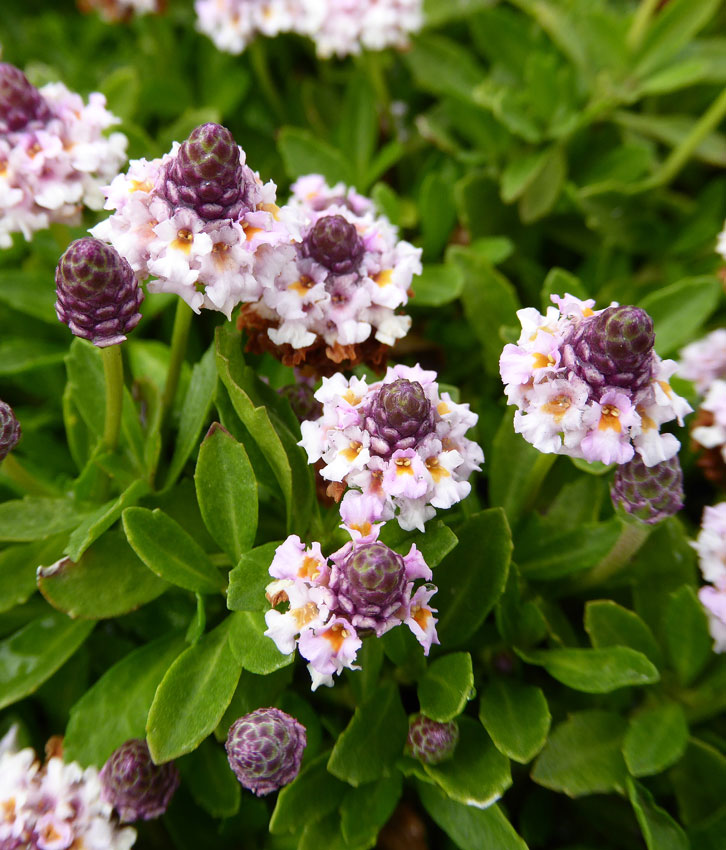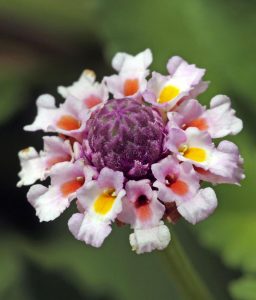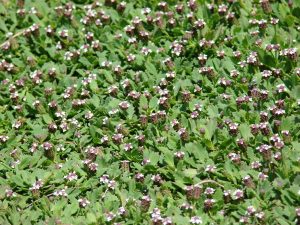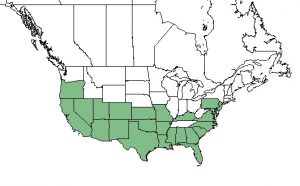
Frog Fruit was not always called Frog Fruit. Photo by Ron Wolf.
It’s only natural that humans are inventive with something that is uniquely their own: Language. A good example are those small vehicles towed behind large Recreational Vehicles. As they are towed and smaller they are called “toads.” An entire culture has evolved around towed toads. The same thing happens with plants.

Many flowering clustering at the node. Photo by Ron Wolf.
Phyla nodiflora (FIE-la nod-dee-FLOR-ah) has at least two common names, Frog Fruit and Match Head. The latter is a more modern term and useage. Wooden matches were invented about 213 years ago. “Frog Fruit” like a towed toad, is a turn of tongue but much older. It started out Fog Fruit. What farmers noticed 700 years ago was that after mowing the grass for hay other species quickly came up. Those were called Fog Fruit as meadows often had fog in the early morning. By a century later Fog Fruit and dampness were connected. It was but a short hop from Fog Fruit to Frog Fruit as that particular species like to grow in damp places where fog developed and frogs like to flop about. The reference “Fog Fruit” is first found in print in the United States in 1886 (the year one of my grandfathers was born.)

It is often found in mats.
To complicate matters there are actually four Frog Fruit locally, P. fruticosa, P. lanceolata, P. nodiflora, and P. stoechadifolia. The latter is woody so we can rule that one out easily. P. lanceolata is rare and found in only three counties in the spring and summer. P. fruticosa is also rare, reported in just one county, and is a tropical American native. That leaves P. nodiflora and the one you are most likely to find. Its leaves are widest above the middle. One major headache is the plant used to be in the Lippia genus and sometimes qualities of plants in that genus are ascribed to this plant now in the Phyla genus. Plants in this genus have a long history of herbal use from treating rheumatism stimulating babies to walk.
Phyla means tribe or clan. The genus was named that by Joao de Louriero, 1717-1791, because of the flowers are in a tight head. He was a Portuguese Jesuit missionary, botanist, paleontologist, and mathematician who spent several decades in what is now Vietnam. Nodiflora means flowers from the nodes. As one might guess it also has a lot of common names among them Turkey Tangle, Sawtooth Frogfruit, Mat Lippia, Mat Frass, Capeweed and Creeping Charlie (as are many, many plants.) In the Verbena family it is the larval host for the Phaon Crescent (Phyciodes phaon), White Peacock (Anartia jatrophae) Barred Sulphur (Eurema daira) and Common Buckeye (Junonia coenia). Good nectar source for hairstreaks.
Green Deane Itemized Plant Profile

Frog Fruit Distribution in North America.
IDENTIFICATION: Mat-forming perennial with prostrate hairy stems. Stems freely branched, rooting at the nodes. Leaves opposite with a few large teeth towards the tip, leaf widest above the middle. Flowers rose-purple or white in t a head at the tip of a long stalk resembling a match head.
TIME OF YEAR: All year
ENVIRONMENT: Damp lawns, beaches, hammocks, disturbed sites, marshes, wet pinelands and glades. Somewhat salt-tolerant. Likes sandy soil and limestone outcrops.
METHOD OF PREPARATION: Leaves boiled (not that good) or dried to make a tea (tastes grassy.)

